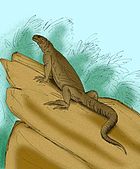| Desertiguana Temporal range: Late Cretaceous | |
|---|---|
| Scientific classification | |
| Domain: | Eukaryota |
| Kingdom: | Animalia |
| Phylum: | Chordata |
| Class: | Reptilia |
| Order: | Squamata |
| Suborder: | Iguania |
| Family: | Phrynosomatidae |
| Genus: | † Desertiguana Alifanov, 2013 |
| Type species | |
| †Desertiguana gobiensis Alifanov, 2013 | |
Desertiguana is an extinct genus of lizard in the family Phrynosomatidae. It is a monotypic genus represented by the type species Desertiguana gobiensis from the Late Cretaceous Barun Goyot Formation of Mongolia. Desertiguana gobiensis is known from a single left lower jaw. [1]




